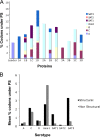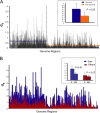Shifts in the selection-drift balance drive the evolution and epidemiology of foot-and-mouth disease virus
- PMID: 19004952
- PMCID: PMC2612391
- DOI: 10.1128/JVI.01500-08
Shifts in the selection-drift balance drive the evolution and epidemiology of foot-and-mouth disease virus
Abstract
Foot-and-mouth disease virus (FMDV) is the causative agent of an acute vesicular disease affecting wild and domesticated animals. Despite the economic burden of the disease and all efforts to eradicate it, FMD outbreaks continue to emerge unexpectedly in developed and developing countries. Correlation of the mutational dynamics of the virus with its epidemiology remains unexplored. Analysis of 103 complete genomes representing the seven serotypes shows the important role that selection plays in the genomic evolution of viral isolates for serotypes. We identified selection and relaxed constraints due to genetic drift through analyses of synonymous sites. Finally, we investigated interactions between mutations that showed coevolving patterns and analyzed, based on protein structures, slightly deleterious and compensatory mutational dynamics. Specifically, we demonstrate that structurally exposed capsid proteins present a greater number of adaptive mutations and relaxed selection than nonstructural proteins. Such events have been magnified during the evolution of the southern African virus types (SATs). These shifts in selection-drift balance have generated the great antigenic and genetic diversity observed for SAT serotypes and that are responsible for epizootics on the continent of Africa. The high number of slightly deleterious and compensatory mutations in SAT serotypes in structural proteins is testament to such balance plasticity. The significant accumulation of these coevolving mutations in African serotypes supports their contribution in generating adaptive immune-escaping mutants and in establishing persistent infections. The reverse of this pattern in nonstructural proteins reveals the neutral fixation of mutations in the more widely spread and commonly studied Euro-Asiatic serotypes.
Figures




Similar articles
-
Full Genome Sequencing Reveals New Southern African Territories Genotypes Bringing Us Closer to Understanding True Variability of Foot-and-Mouth Disease Virus in Africa.Viruses. 2018 Apr 13;10(4):192. doi: 10.3390/v10040192. Viruses. 2018. PMID: 29652800 Free PMC article.
-
Differential Persistence of Foot-and-Mouth Disease Virus in African Buffalo Is Related to Virus Virulence.J Virol. 2016 Apr 29;90(10):5132-5140. doi: 10.1128/JVI.00166-16. Print 2016 May 15. J Virol. 2016. PMID: 26962214 Free PMC article.
-
Development of a universal RT-PCR for amplifying and sequencing the leader and capsid-coding region of foot-and-mouth disease virus.J Virol Methods. 2013 Apr;189(1):70-6. doi: 10.1016/j.jviromet.2013.01.009. Epub 2013 Feb 1. J Virol Methods. 2013. PMID: 23380590
-
Aspects of the persistence of foot-and-mouth disease virus in animals--the carrier problem.Microbes Infect. 2002 Aug;4(10):1099-110. doi: 10.1016/s1286-4579(02)01634-9. Microbes Infect. 2002. PMID: 12191660 Review.
-
Evolution of foot-and-mouth disease virus.Virus Res. 2003 Jan;91(1):47-63. doi: 10.1016/s0168-1702(02)00259-9. Virus Res. 2003. PMID: 12527437 Review.
Cited by
-
Identification of diffusion routes of O/EA-3 topotype of foot-and-mouth disease virus in Africa and Western Asia between 1974 and 2019 - a phylogeographic analysis.Transbound Emerg Dis. 2022 Sep;69(5):e2230-e2239. doi: 10.1111/tbed.14562. Epub 2022 Jun 3. Transbound Emerg Dis. 2022. PMID: 35435315 Free PMC article.
-
Evaluation of novel inactivated vaccines for the SAT 1, SAT 2 and SAT 3 serotypes of foot-and-mouth disease in pigs.Virol J. 2019 Dec 16;16(1):156. doi: 10.1186/s12985-019-1262-1. Virol J. 2019. PMID: 31842907 Free PMC article.
-
Clinical, molecular detection and phylogenetic analysis study of local foot-and-mouth disease virus in Al-Qadisiyah province of Iraq.Vet World. 2018 Sep;11(9):1210-1213. doi: 10.14202/vetworld.2018.1210-1213. Epub 2018 Sep 4. Vet World. 2018. PMID: 30410223 Free PMC article.
-
Adaptive value of foot-and-mouth disease virus capsid substitutions with opposite effects on particle acid stability.Sci Rep. 2021 Dec 6;11(1):23494. doi: 10.1038/s41598-021-02757-3. Sci Rep. 2021. PMID: 34873184 Free PMC article.
-
Evolutionary ecology of virus emergence.Ann N Y Acad Sci. 2017 Feb;1389(1):124-146. doi: 10.1111/nyas.13304. Epub 2016 Dec 30. Ann N Y Acad Sci. 2017. PMID: 28036113 Free PMC article. Review.
References
-
- Akashi, H. 1999. Within- and between-species DNA sequence variation and the ‘footprint’ of natural selection. Gene 23839-51. - PubMed
-
- Batschelet, E., E. Domingo, and C. Weissmann. 1976. The proportion of revertant and mutant phage in a growing population, as a function of mutation and growth rate. Gene 127-32. - PubMed
-
- Chamary, J. V., J. L. Parmley, and L. D. Hurst. 2006. Hearing silence: non-neutral evolution at synonymous sites in mammals. Nat. Rev. Genet. 798-108. - PubMed
Publication types
MeSH terms
Substances
LinkOut - more resources
Full Text Sources
Research Materials

